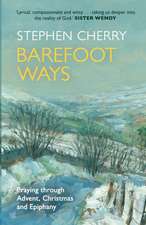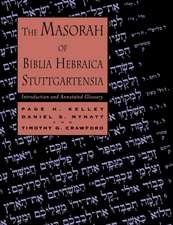The Epistle of Second Baruch: A Study in Form and Message: The Library of Second Temple Studies
Autor Mark Whittersen Limba Engleză Hardback – 30 apr 2003
Din seria The Library of Second Temple Studies
- 22%
 Preț: 831.30 lei
Preț: 831.30 lei - 22%
 Preț: 832.52 lei
Preț: 832.52 lei - 22%
 Preț: 237.75 lei
Preț: 237.75 lei - 22%
 Preț: 888.44 lei
Preț: 888.44 lei - 22%
 Preț: 888.10 lei
Preț: 888.10 lei - 22%
 Preț: 947.28 lei
Preț: 947.28 lei - 31%
 Preț: 768.85 lei
Preț: 768.85 lei - 22%
 Preț: 257.57 lei
Preț: 257.57 lei - 31%
 Preț: 771.61 lei
Preț: 771.61 lei - 14%
 Preț: 1009.30 lei
Preț: 1009.30 lei - 22%
 Preț: 948.09 lei
Preț: 948.09 lei - 22%
 Preț: 1003.84 lei
Preț: 1003.84 lei - 31%
 Preț: 951.35 lei
Preț: 951.35 lei - 22%
 Preț: 1153.41 lei
Preț: 1153.41 lei - 13%
 Preț: 256.64 lei
Preț: 256.64 lei - 22%
 Preț: 1064.58 lei
Preț: 1064.58 lei - 31%
 Preț: 773.00 lei
Preț: 773.00 lei - 22%
 Preț: 1064.81 lei
Preț: 1064.81 lei - 22%
 Preț: 1478.32 lei
Preț: 1478.32 lei - 31%
 Preț: 889.64 lei
Preț: 889.64 lei - 22%
 Preț: 1067.67 lei
Preț: 1067.67 lei - 22%
 Preț: 1640.12 lei
Preț: 1640.12 lei - 22%
 Preț: 1064.90 lei
Preț: 1064.90 lei - 22%
 Preț: 716.02 lei
Preț: 716.02 lei - 22%
 Preț: 946.63 lei
Preț: 946.63 lei - 31%
 Preț: 945.97 lei
Preț: 945.97 lei - 22%
 Preț: 1005.47 lei
Preț: 1005.47 lei - 31%
 Preț: 1062.37 lei
Preț: 1062.37 lei - 31%
 Preț: 771.78 lei
Preț: 771.78 lei - 22%
 Preț: 1124.24 lei
Preț: 1124.24 lei - 31%
 Preț: 945.25 lei
Preț: 945.25 lei - 13%
 Preț: 258.18 lei
Preț: 258.18 lei - 22%
 Preț: 943.36 lei
Preț: 943.36 lei - 22%
 Preț: 259.49 lei
Preț: 259.49 lei - 14%
 Preț: 1152.45 lei
Preț: 1152.45 lei - 31%
 Preț: 769.74 lei
Preț: 769.74 lei - 31%
 Preț: 773.00 lei
Preț: 773.00 lei - 14%
 Preț: 768.36 lei
Preț: 768.36 lei - 22%
 Preț: 771.05 lei
Preț: 771.05 lei - 22%
 Preț: 1064.26 lei
Preț: 1064.26 lei - 22%
 Preț: 946.88 lei
Preț: 946.88 lei - 22%
 Preț: 1488.42 lei
Preț: 1488.42 lei - 31%
 Preț: 1008.88 lei
Preț: 1008.88 lei - 22%
 Preț: 651.23 lei
Preț: 651.23 lei
Preț: 1064.97 lei
Preț vechi: 1367.59 lei
-22% Nou
Puncte Express: 1597
Preț estimativ în valută:
203.81€ • 211.71$ • 169.30£
203.81€ • 211.71$ • 169.30£
Carte tipărită la comandă
Livrare economică 03-17 februarie 25
Preluare comenzi: 021 569.72.76
Specificații
ISBN-13: 9780826462169
ISBN-10: 0826462162
Pagini: 212
Dimensiuni: 156 x 234 x 19 mm
Greutate: 0.55 kg
Editura: Bloomsbury Publishing
Colecția Sheffield Academic Press
Seria The Library of Second Temple Studies
Locul publicării:London, United Kingdom
ISBN-10: 0826462162
Pagini: 212
Dimensiuni: 156 x 234 x 19 mm
Greutate: 0.55 kg
Editura: Bloomsbury Publishing
Colecția Sheffield Academic Press
Seria The Library of Second Temple Studies
Locul publicării:London, United Kingdom
Recenzii
"In the present renaissance of pseudepigrapha study, the 'epistle' of the Syriac Apocalypse of Baruch (2 Baruch 78-87) seems to have been overlooked. This study is one of the first major attempts to address this important writing. The years following the fall of Jerusalem in 70 were traumatic ones in which various movements for religious reconstruction were pressing their visions for the future. The one that won out was the rabbinic model, but there were others. The Epistle of Second Baruch was unusual in reaching out to gentiles. Its proposal for leadership of the community was based on the Law but differed fundamentally from the rabbinic in its apocalyptic outlook. Whitters examines the Epistle in the light of epistolary models of letter-writing at the time, and in its literary and historical context, to provide new insights into this pivotal period in Jewish history." --Professor Lester Grabbe












